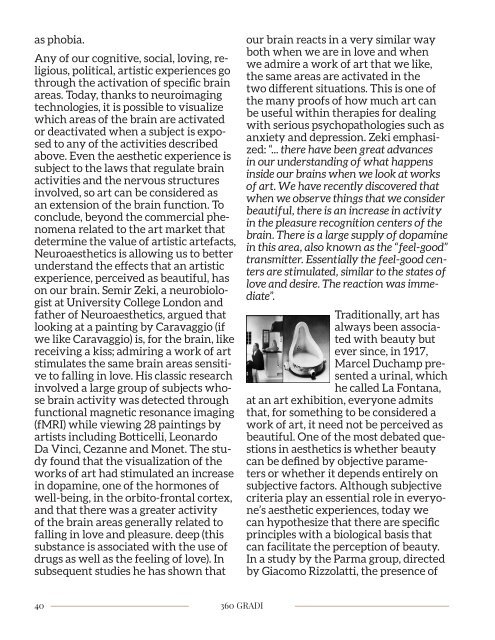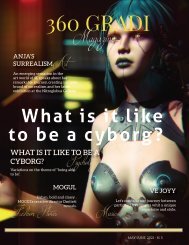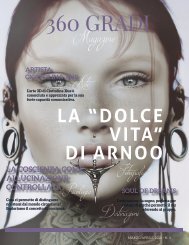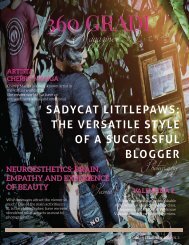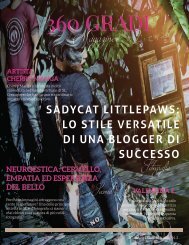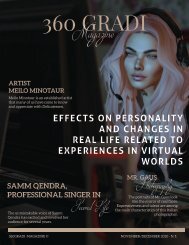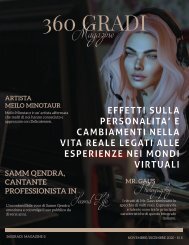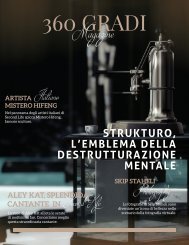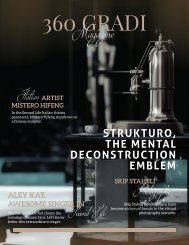360 GRADI MAGAZINE // March-April 2021
360 GRADI Magazine is the trendy, elegant, refined, and sophisticated publishing about Second Life (the virtual world by Linden Lab). Out every two months.
360 GRADI Magazine is the trendy, elegant, refined, and sophisticated publishing about Second Life (the virtual world by Linden Lab).
Out every two months.
Create successful ePaper yourself
Turn your PDF publications into a flip-book with our unique Google optimized e-Paper software.
as phobia.<br />
Any of our cognitive, social, loving, religious,<br />
political, artistic experiences go<br />
through the activation of specific brain<br />
areas. Today, thanks to neuroimaging<br />
technologies, it is possible to visualize<br />
which areas of the brain are activated<br />
or deactivated when a subject is exposed<br />
to any of the activities described<br />
above. Even the aesthetic experience is<br />
subject to the laws that regulate brain<br />
activities and the nervous structures<br />
involved, so art can be considered as<br />
an extension of the brain function. To<br />
conclude, beyond the commercial phenomena<br />
related to the art market that<br />
determine the value of artistic artefacts,<br />
Neuroaesthetics is allowing us to better<br />
understand the effects that an artistic<br />
experience, perceived as beautiful, has<br />
on our brain. Semir Zeki, a neurobiologist<br />
at University College London and<br />
father of Neuroaesthetics, argued that<br />
looking at a painting by Caravaggio (if<br />
we like Caravaggio) is, for the brain, like<br />
receiving a kiss; admiring a work of art<br />
stimulates the same brain areas sensitive<br />
to falling in love. His classic research<br />
involved a large group of subjects whose<br />
brain activity was detected through<br />
functional magnetic resonance imaging<br />
(fMRI) while viewing 28 paintings by<br />
artists including Botticelli, Leonardo<br />
Da Vinci, Cezanne and Monet. The study<br />
found that the visualization of the<br />
works of art had stimulated an increase<br />
in dopamine, one of the hormones of<br />
well-being, in the orbito-frontal cortex,<br />
and that there was a greater activity<br />
of the brain areas generally related to<br />
falling in love and pleasure. deep (this<br />
substance is associated with the use of<br />
drugs as well as the feeling of love). In<br />
subsequent studies he has shown that<br />
our brain reacts in a very similar way<br />
both when we are in love and when<br />
we admire a work of art that we like,<br />
the same areas are activated in the<br />
two different situations. This is one of<br />
the many proofs of how much art can<br />
be useful within therapies for dealing<br />
with serious psychopathologies such as<br />
anxiety and depression. Zeki emphasized:<br />
“... there have been great advances<br />
in our understanding of what happens<br />
inside our brains when we look at works<br />
of art. We have recently discovered that<br />
when we observe things that we consider<br />
beautiful, there is an increase in activity<br />
in the pleasure recognition centers of the<br />
brain. There is a large supply of dopamine<br />
in this area, also known as the “feel-good”<br />
transmitter. Essentially the feel-good centers<br />
are stimulated, similar to the states of<br />
love and desire. The reaction was immediate”.<br />
Traditionally, art has<br />
always been associated<br />
with beauty but<br />
ever since, in 1917,<br />
Marcel Duchamp presented<br />
a urinal, which<br />
he called La Fontana,<br />
at an art exhibition, everyone admits<br />
that, for something to be considered a<br />
work of art, it need not be perceived as<br />
beautiful. One of the most debated questions<br />
in aesthetics is whether beauty<br />
can be defined by objective parameters<br />
or whether it depends entirely on<br />
subjective factors. Although subjective<br />
criteria play an essential role in everyone’s<br />
aesthetic experiences, today we<br />
can hypothesize that there are specific<br />
principles with a biological basis that<br />
can facilitate the perception of beauty.<br />
In a study by the Parma group, directed<br />
by Giacomo Rizzolatti, the presence of<br />
40 <strong>360</strong> <strong>GRADI</strong>


